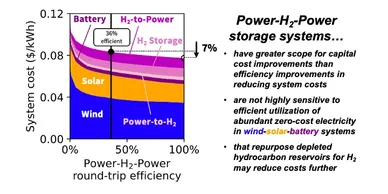publications
2024
-
 The Influence of Regional Geophysical Resource Variability on the Value of Single- and Multistorage Technology PortfoliosAnna X. Li, Edgar Virgüez, Jacqueline A. Dowling, Alicia Wongel, Dominic Covelli, Tyler H. Ruggles, Natasha Reich, Nathan S. Lewis, and Ken CaldeiraEnvironmental Science & Technology, Jul 2024Publisher: American Chemical Society
The Influence of Regional Geophysical Resource Variability on the Value of Single- and Multistorage Technology PortfoliosAnna X. Li, Edgar Virgüez, Jacqueline A. Dowling, Alicia Wongel, Dominic Covelli, Tyler H. Ruggles, Natasha Reich, Nathan S. Lewis, and Ken CaldeiraEnvironmental Science & Technology, Jul 2024Publisher: American Chemical SocietyA stylized macro-scale energy model of least-cost electricity systems relying only on wind and solar generation was used to assess the value of different storage technologies, individually and combined, for the contiguous U.S. as well as for four geographically diverse U.S. load-balancing regions. For the contiguous U.S. system, at current costs, when only one storage technology was deployed, hydrogen energy storage produced the lowest system costs, due to its energy-capacity costs being the lowest of all storage technologies modeled. Additional hypothetical storage technologies were more cost-competitive than hydrogen (long-duration storage) only at very low energy-capacity costs, but they were more cost-competitive than Li-ion batteries (short-duration storage) at relatively high energy- and power-capacity costs. In all load-balancing regions investigated, the least-cost systems that included long-duration storage had sufficient energy and power capacity to also meet short-duration energy and power storage needs, so that the addition of short-duration storage as a second storage technology did not markedly reduce total system costs. Thus, in electricity systems that rely on wind and solar generation, contingent on social and geographic constraints, long-duration storage may cost-effectively provide the services that would otherwise be provided by shorter-duration storage technologies.
-
 Opportunities and constraints of hydrogen energy storage systemsJacqueline A. Dowling, Tyler Ruggles, Edgar Virgüez, Natasha D. Reich, Zachary P. Ifkovits, Steven J Davis, Anna X. Li, Kathleen Kennedy, Katherine Z. Rinaldi, Lei Duan, Ken Caldeira, and Nathan S LewisEnvironmental Research: Energy, Jul 2024
Opportunities and constraints of hydrogen energy storage systemsJacqueline A. Dowling, Tyler Ruggles, Edgar Virgüez, Natasha D. Reich, Zachary P. Ifkovits, Steven J Davis, Anna X. Li, Kathleen Kennedy, Katherine Z. Rinaldi, Lei Duan, Ken Caldeira, and Nathan S LewisEnvironmental Research: Energy, Jul 2024In contrast to battery storage systems, power-to-hydrogen-to-power (P-H2-P) storage systems provide opportunities to separately optimize the costs and efficiency of the system’s charging, storage, and discharging components. The value of capital cost reduction relative to round-trip efficiency improvements of P-H2-P systems is not well understood in electricity systems with abundant curtailed power. Here, we used a macro-energy model to evaluate the sensitivity of system costs to techno-economic characteristics of P-H2-P systems in stylized wind-solar-battery electricity systems with restricted natural gas generation. Assuming current costs and current round-trip P-H2-P efficiencies, least-cost wind and solar electricity systems had large amounts of excess variable renewable generation capacity. These systems included P-H2-P in the least-cost solution, despite its low round-trip efficiency and relatively high P-H2-P power discharge costs. These electricity system costs were not highly sensitive to the efficient use of otherwise-curtailed power, but were sensitive to the capital cost of the P-H2-P power discharge component. If the capital costs of the charging and discharging components were decreased relative to generation costs, curtailment would decrease, and electricity system costs would become increasingly sensitive to improvements in the P-H2-P round-trip efficiency. These results suggest that capital cost reductions, especially in the discharge component, should be a key priority for innovation in P-H2-P systems for applications in electricity systems dominated by wind and solar generation. Analysis of underground salt cavern storage constraints in U.S.-based wind and solar scenarios suggests that ample hydrogen storage capacity could be obtained by repurposing the depleted natural gas reservoirs that are currently used for seasonal natural gas storage.
-
 Catalysis of the Oxygen-Evolution Reaction in 1.0 M Sulfuric Acid by Manganese Antimonate Films Synthesized via Chemical Vapor DepositionJacqueline A. Dowling, Zachary P. Ifkovits, Azhar I. Carim, Jake M. Evans, Madeleine C. Swint, Alexandre Z. Ye, Matthias H. Richter, Anna X. Li, and Nathan S. LewisACS Applied Energy Materials, May 2024Publisher: American Chemical Society
Catalysis of the Oxygen-Evolution Reaction in 1.0 M Sulfuric Acid by Manganese Antimonate Films Synthesized via Chemical Vapor DepositionJacqueline A. Dowling, Zachary P. Ifkovits, Azhar I. Carim, Jake M. Evans, Madeleine C. Swint, Alexandre Z. Ye, Matthias H. Richter, Anna X. Li, and Nathan S. LewisACS Applied Energy Materials, May 2024Publisher: American Chemical SocietyManganese antimonate (MnySb1–yOx) electrocatalysts for the oxygen-evolution reaction (OER) were synthesized via chemical vapor deposition. Mn-rich rutile Mn0.63Sb0.37Ox catalysts on fluorine-doped tin oxide (FTO) supports drove the OER for 168 h (7 days) at 10 mA cm–2 with a time-averaged overpotential of 687 ± 9 mV and with \textgreater97% Faradaic efficiency. Time-dependent anolyte composition analysis revealed the steady dissolution of Mn and Sb. Extended durability analysis confirmed that Mn-rich MnySb1–yOx materials are more active but dissolve at a faster rate than previously reported Sb-rich MnySb1–yOx alloys.